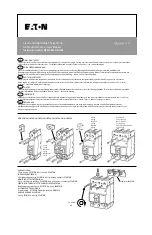
54
PowerVac
®
5kV Vertical Lift
Chapter 14. Stationary Cubicle Subassembly
If it is necessary to align the doors of the breaker
compartment, the following procedure should
be followed.
1.
Doors may be raised or lowered verti-
cally, or moved forward or backward hori-
zontally, by loosening the hinge mount-
ing nuts on the left side sheet and shifting
the hinge and door assembly as allowed
by the slotted holes in the hinge.
2.
Doors may be shifted to the right or left
by adding or removing washers or shims
from between the hinge and side sheet.
3.
Doors may be plumbed by slightly bend-
ing the appropriate hinges. To do this, open
the door and insert a drift pin in either of
the two holes in the hinge. Pulling forward
on the drift pin will move the door to the
right, and pushing back will move the door
to the left. Adjust each hinge individually
as required to plumb the door.
14-3 Testing and Inspection
1. General
Although the breaker has been completely
tested at the factory, a final field inspection and
test should be made to be sure that the equip-
ment has been properly installed and that all
connections are correct and have not become
loose in transportation. Reference Chapter 4.
WARNING:
THE PRIMARY EQUIPMENT
SHOULD BE COMPLETELY DE-ENERGIZED
WHILE THE TESTS ARE IN PROGRESS.
2. Breaker Testing
The operation of the breaker with its associ-
ated devices may be tested outside the unit by
use of the test coupler. Reference Chapter 9.
3. Hi-potential Testing
Hi-potential tests to check the integrity of the
switchgear insulation is not necessary, if the
insulation has been previously checked during
maintenance. Should the purchaser desire to
make hi-potential tests, the test voltage should
not exceed 14kV AC at 60 Hz. This voltage is
75% of factory test voltage and is in accordance
with ANSI standards.
4. Breaker Positioning
Before proceeding to place the breaker in the
operating position,the steps as outlined in
Chapter 4 must be taken.
WARNING:
DO NOT INSTALL OR REMOVE
THE BREAKER OR MAKE ADJUSTMENTS
UNLESS THE BREAKER IS OPEN.
4.1.
Rub a small amount of 0282A2048P009
lubricant on the silvered portion of the
breaker studs, ground shoe, and 16 sec-
ondary coupler pins, to form a thin coat-
ing for contact purposes.
4.2.
Lower the elevating mechanism lifting
brackets until the lifting brackets are in
the fully lowered position. The breaker
should then enter the housing freely.
After first assuring that the breaker is in
the open position, push the breaker into
the unit until it rests against the rear of
the front lifting saddle of the elevating
mechanism.
4.3.
The clearance between the interference
block on the breaker and the interference
block on the interlock mechanism
should be from .063" to .125". Figure 6.
WARNING:
AGAIN, BEFORE PROCEEDING
WITH THIS CHECK, IT IS NECESSARY THAT
THE PRIMARY CIRCUITS BE DE-ENERGIZED.
4.4.
To elevate the breaker, place the elevat-
ing control selector switch on the elevat-
ing motor to “RAISE”. A clutch handle
under the elevating motor is then pulled
forward until a limit switch engages to
raise the breaker into the unit. Carefully
raise the breaker and while elevating,
note that the shutter slides open and the
breaker studs center with respect to the
openings in the stationary disconnect-
ing devices or damage to the contacts
may result.
4.5.
Hold the clutch handle in the forward
position until a limit switch on the struc-
ture opens to stop the motor at the end
of the upward travel of the breaker. The
springs will charge when the clutch
handle is released. Figure 53.
CAUTION:
THE MOTOR RAISE/LOWER SE-
LECTOR SWITCH MUST NOT BE USED TO
ENERGIZE OR INTERRUPT MOTOR CIRCUIT
AT ANY TIME.
4.6.
When the breaker is fully elevated, the
clearance between the breaker lifting rail
and the upper stop bolts should not be
more than .125" and not less than .094".















































